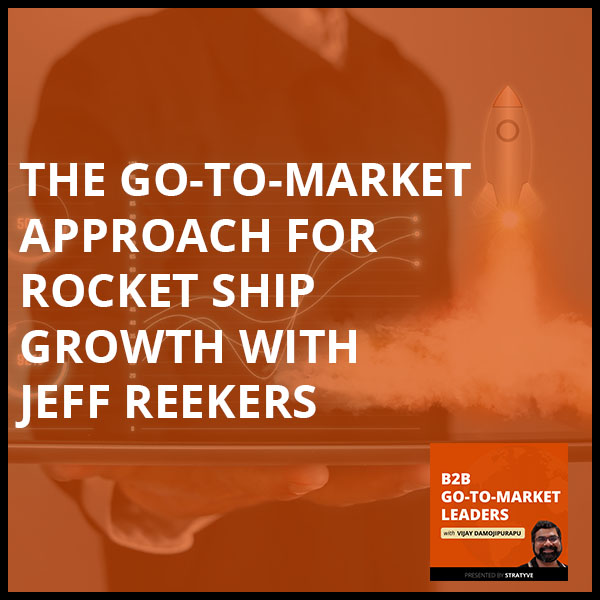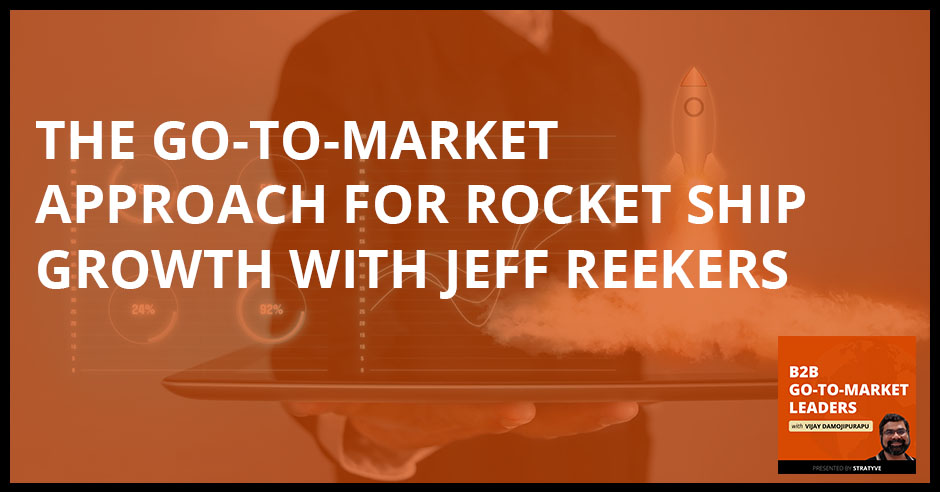

Content is king, as Bill Gates once said. But how can organizations truly optimize their content strategy? In this episode, Vijay Damojipurapu is joined by Sarah Allen-Short, Vice President of Marketing for Give And Take, Inc. Also known as the Marketing Doula, Sarah sheds some light on how content is fundamental not only in driving sales but in optimizing internal processes as well. She explains how businesses should incorporate content strategy into the sales process and create alignment within an organization. She also explains how she advises clients by providing support, information, and assistance as they “birth” their product. Tune in for some useful tips on how you can advance your business with content strategy.
—
Listen to the podcast here
How Content Strategy Leads To Better Results With Sarah Allen-Short
I have with me Sarah Allen-Short who is the VP of Marketing at Give and Take. She’s got a very interesting and varied background all the way from corporate communications to being part of a PR agency to running marketing for small companies and startups. She’s also part of the Peak Community. Sarah, welcome. I look forward to an engaging conversation with you.
Thank you so much for having me.
The question that I always start off the show with is, how do you define a go-to-market?
I define it with the simplest possible definition which is the way that a company brings any new product or service to the market. Whether that’s a new product in an existing market or a new market for an existing product or service, it’s just the way that you do that.
Do you see it as a one-time activity or is this ongoing?
Definitely not. It’s ongoing. If you’re growing your company, you’re always going to be introducing new products, new features, new services, or you’re going to be taking the ones you already have into new markets. I suppose if you sold one widget, you only sold it to retailers, and you did that for 30 years, you might not be thinking about it as a go-to-market strategy the whole time. Even then, honestly, the way the marketplace changes, I think you still would be.
That’s one of the reasons why I’m excited to have you on the show because that content is a key piece within the whole go-to-market engine. The way I look at this is content is the currency for sales, marketing, and go-to-market functions. It’s similar to how code is to a software engineer or software engineering product that are code-based.
I think often B2B companies overlook content, especially thought leadership content because they think they can’t afford it. They think it’s a luxury. When you’re doing it right, it can be very cost-effective and efficient. It can be the engine that drives every single other thing you do. I was in a meeting with one of my clients. I have a full-time day job but I also do some consulting. I was in a meeting where they’re hiring a new designer and a new content writer. They’re asking me to onboard and help train them. I told them, “What you guys do drives every single other thing that this team of twenty does. All the people working in social media, regional marketing, demand gen, everything that every product marketing and everyone else is doing on this team starts the seed of what they do. It starts with what you two are going to create as the actual content writer and the designer. I totally agree with you.
I know you have been in and out and completely in it within the whole content, content strategy, and content marketing world. On a lighter note, when you ask your kids this question, how do your kids describe what you do for a living or what do you do at work?
They say that I worked for Adam Grant because he’s the cofounder of our company. They know that I do marketing. It’s interesting. I might ask them. I have teenagers. I would be curious to hear what they say. I think they probably would say, “You make things sound good so that people want to buy them.” Beyond that, they would have no idea what I do. My very first job out of college was in PR so my parents still think I do PR even though I have not focused on PR in at least nine years. I do a little bit of everything but as a core part of my job function, my dad still regularly asks me, “When was the last time you talked to this journalist or that journalist?” I don’t do that anymore.
Content has the power to be an engine that drives everything else. Click To TweetIt’s funny, especially with parents. I think it’s imprinted in their brains. They somehow tend to recall the first job that you do. That is your career for the rest of your life.
I put myself through college as a telemarketer. I’m glad they didn’t land on that one. They updated it a little bit after that.
Talk to us about your overall career journey. I know you’ve done work at an ad agency. You also worked on the other side, in-house. Talk to us about your career journey as well as what you do at Adam Grant’s company.
Very early in my career towards the end of college, I was working in advertising. I did that because what I wanted to do was to be a journalist. I thought that if I started working in advertising at a magazine, I could get into journalism because I did not understand that is the worst way to get into journalism. Any reputable magazine has a strict separation between advertising and the editorial side. I didn’t know that, but I got into marketing. I was born and raised in Richmond, Virginia, which is a town that I was desperate to get out of in my teenage years. When I graduated from college, I wanted to go to DC and started looking for a job.
The first time I got to DC, I was 25. I was on the PR side after being in advertising for a few years. I don’t know how I got the job. What we did was we did stakeholder relations and communications for universities, NGOs, and it was a lot of fun. It was really interesting. I started to learn some fundamental principles. I had a great mentor there. We did some cool projects. I think when you work at an agency, you get exposed to so many different kinds of companies. I was working on a project with Madeleine Albright at the University of Michigan. I was working with the US Forest Service on a project to teach and attract Urban Americans into the forest. I’m trying to get people who live in urban centers interested in the forest. I was teaching low-income people energy-saving skills. It was just a lot of fun. It was fun to live in DC at that time.
I’ll never forget, the very first article that I ever got was in the South Florida Laundry News. I didn’t even know there were magazines for that. This was in the early 2000s but we still did all PR with an actual book called The Yellow Book. Some of your readers will remember. Anyway, one of my clients was a startup that had come out of the University of Michigan that was doing web analytics or customer satisfaction analytics called ForeSee. They were one of my biggest clients and they eventually brought me on full-time. At that point, they were in Michigan, I was in DC. I decided to move back to Richmond because it’s half the price to live in Richmond than it is to live in DC. I had been working with them since they were founded as a consultant. When I came on staff in 2007, I worked with them for about seven more years until they were acquired. That was a huge learning process for me because it was a lucrative acquisition but not an emotionally easy acquisition.
One of the things that we don’t talk about enough in the startup tech world, in the B2B SaaS tech world is the emotions behind an acquisition. After that, I did consulting for 3 or 4 years where I served as a Fractional CMO. My background is all technology, startups, SaaS, B2B, all in that space. I worked for a payroll company, a biotech startup, a marketing services firm, all sorts of things like that. The CEO from ForeSee came to me and said, “Adam Grant is starting a company and we want you as the head of marketing.” Where I work now, Give and Take, we have two solutions. One is an exercise that helps increase generosity in the workplace. The other is a knowledge-sharing platform. Those of you who are familiar with Adam Grant’s work, he studies generosity, particularly in the workplace. His partner in the startup, Wayne Baker, studies asking for help. We help companies teach their employees how to ask for help, exchange knowledge, generously share, how to practice it, and then how to scale it at an organization. That’s where I am now. I’ve been there since 2017.
It’s a very varied and colorful journey. As a context for the readers, I first saw your quality of work and thought process when you and I are part of the Peak Community started by Sangram Vajre and a couple of others. I still recall that you presented the content strategy framework or a template. That was one of the meeting points where I got an insight into how you think about content. If I connect the dots to your all career journey, because you’ve worked at both at an ad agency across diverse projects for NGOs, government and corporate. You’ve seen that spectrum. Clearly, you know how to tell stories. That’s a key part of a content brand.
I know you’re going to ask me about some specific examples. When I was at ForeSee, I had an opportunity to run a pretty large original research team. I saw the power that content could have as an engine to drive everything else that was happening. When our company got acquired, the CEO said that the content strategy was one of the top three reasons that he thought we had gotten the valuation that we had gotten. It can impact much. It’s not just a loosey-goosey write an eBook and see what happens. It can impact market valuation.
I think this is something that’s not well understood by founders and CEOs, let alone marketing leaders. Content plays a key role. As you say, it’s not about just putting out a blog post, a social media post or a white paper on an eBook. It’s a lot more than that. The key point is, how do you tie in? In your mind, you’re a visionary when it comes to storytelling across channels on a given timeline. How do you tell that? If done right, it increases the revenue and growth but it increases the valuation of the company. I want you to reiterate that point.

At the very fundamental level, you’re looking at things like MQLs and SQLs. You’re going to increase leads. If that’s where you want to stop, that’s great. What our CEO said to me when we were acquired was the way that we positioned the company in our thought leadership and content strategy, the way that we used our content and thought leadership to get covered in the New York Times, the Washington Post, NPR, CNN and Bloomberg, the way that we used it to drive leads and expand deals, we had land and expand strategy, and we’d be in with a company and use content strategy to spread our tentacles within that company, he felt like it was a critical part of our success. He put the budget behind it too. We had not an insignificant amount of budget behind that effort. We had a team of 5 out of 15 or 20 marketing people just working on content and thought leadership, and a budget of a few million dollars for that, not including salaries.
I’m working with the same CEO. It’s a lot of fun because he does understand that. If you have a visionary CEO that understands that, honestly, he taught me that. Now that I’m looking back on it, I’m the marketing expert but he believed in it before I did. I think of him as a real mentor of mine. I saw it work so well at that company. Even if you don’t have a visionary CEO who doesn’t understand that content can affect and impact market valuation, that’s hard to quantify. You can at least be talking about SQLs, MQLs or website traffic. There are definite ways to measure content that you can show the value of.
You mentioned that you had a team of five within the content marketing team. You also mentioned a budget of a few million dollars. What percentage of the revenue was that few million dollars? Is it like 5% or 10% less?
I am not sure, honestly. It’s been a few years now. I would say it was probably 30% or 40% of the marketing budget and 30% of the marketing staff. I’m not sure about it relative to the entire revenue of the entire company by the time we were sold. I just don’t remember those details. I should go look because that’s a good thing to know.
The reason why I’m poking you on this is I’ve seen various studies. I was running my marketing teams as well. A big chunk of it was called out for content. I’m talking about a few years ago but right now, with the stack and the tech stack that we have, it’s a lot easier. There is this whole gray area of there are certain things you can measure but not everything. For example, you can keep putting your posts. You can post great content on LinkedIn and social media like Twitter and all those. It’s very hard for you to tie it back to metrics but someone comes and says, “The reason I reached out to you is that I can relate to what you’re saying. I can see the expertise that you wrote on LinkedIn or Twitter.” Let’s dive deeper into that whole content strategy and the execution piece that you did at ForeSee. Talk to us about the situation. What were some of the calls that you’re looking at when you’re talking about and thinking about the whole PR strategy, as well as the thought leadership content?
The situation at ForeSee was that we were a relatively unknown company in a relatively new market that wasn’t defined, which was web analytics at that time. It grew and evolved to be more like customer experience analytics. This was before Qualtrics and any of those big companies were in the game. This was 2001 when it started. We had an academic methodology that we knew could measure online customer satisfaction in a way that predicted the future. What we needed to do was convince everybody of that. This is a little different from some of the things I’ve done at other places. We can talk about that too.
The strategy we took was to do original research and use that to get media coverage. We did a few different studies. We worked with a retail trade publication and we did a survey of retailers and said, “What do you think customers think about all this stuff?” We then surveyed customers and we went out to the media and said, “Retailers don’t know what customers want. They’re dead wrong.” That gave us the idea to start doing research just among customers. What we started doing is what we call the Satisfaction Index. It became the ForeSee Experience Index over time, the FXI. What we did was we went out in a number of industries and channels. We would pay a panel company to measure customer satisfaction. At one point, we did the top 100 retailers, the top 10 mobile sites, the top 20 banks, and the top 10 utilities, depending on the market. We did a number of these studies and that was the bulk of our external budget.
We would release these reports saying that Amazon is number one and Apple is number two. What we did was we leveraged it for all it was worth. We got regular coverage in the Wall Street Journal and the New York Times for this study, which is a little harder to do now. We’re not using Survey Monkey to ask people, “What do you think is the best retailer?” We had a methodology we could depend on. We got a ton of PR coverage but then we also went and we marketed to those companies. We said, “Amazon, did you know you’re number one? You should tell all your users.” For a long time, Amazon would put up a landing page on their homepage, “Amazon rated number one in the FXI,” so we started to get known for this.
This was in the early 2000s.
It started in the early 2000s and went all the way through. A few times, they were acquired by Verint. It’s now the VXI. They still do it.
The real magic of content strategy is connecting it to the sales process. Click To TweetGoing back to when you reached out to Amazon, this was in the early 2000s or mid-2000s.
I would say 2008, 2009 probably in Amazon. The real magic though of this content strategy was connecting it to sales. Once we start to arm sales with, here’s a list of the top 100 retailers, here’s how to go use this to get meetings with all 100 of those retailers, and here’s how to use it to get meetings with the other 9,000 retailers that aren’t on the list and say, “We know what the best of the best we’re doing. We can show you how to do it. We can show you how to keep up.” What we did is a little bit of ABM. It was the early days of ABM. I don’t even think ABM was a term then. What we started to do was we would do a template of a briefing deck and the salespeople could customize it. I’ve worked at so many places where sales and marketing butt heads.
Every place I’ve ever worked at, sales loves marketing. When your sales and you can walk into the room and throw the Wall Street Journal down on the table and say, “Look at our company in the Wall Street Journal,” or you can put down a real eBook or white paper that looks legit, it gives you so much credibility. When you’re a salesperson and you have to email somebody every week for six months saying, “Do you have time yet?” When we are giving them a dribble of content, instead of just saying, “Do you have time yet?” They’re saying, “Did you see our blog post on this? Did you see our eBook on this? Did you see our infographic on this? By the way, do you have time yet?” It makes it so much easier for them. They should look at marketing as making their jobs so much easier. Not as so many sales teams do, the weak link that if only marketing was working well, we would be able to do our jobs well. The real magic is connecting the content to the sales process.
On that point, I want to emphasize this for our readers and for folks who are looking to seriously connect the dots between content to revenue. I think what you highlighted there is marketing doing its job. When it comes to putting out a good blog post and good insights on the website, that’s just the beginning. Additionally, on top, you’re also highlighting the kind of press coverage you’re getting at tier-one publications.
In terms of measurement, you can measure how many what we used to call IPMs, Initial Prospect Meetings, come as a result of one of these emails. You can measure up marketing attribution. When you do a big formal campaign like, “We did this index. We’re doing customized decks for different companies,” you can measure how many deals came in that were initiated by that effort. You can start to say, “You’re giving me $1 million to do this retail study. It brought in $6 million in sales. We should try this again with utilities and banks.” It’s hard in early startup days to worry too much about metrics. It takes a lot of time, energy, and it takes away from doing. In early startup days, you have to try stuff. I think that marketers are not honest enough about proving their own worth. There’s a lot of C-suite executives that are skeptical that marketing can help. If you can’t show them how it does, you shouldn’t expect more budget.
I think the other part that was going well for you was a CEO who knew the value of marketing.
Absolutely. I was someone who believes strongly in content. I hear a lot of people on Peak talking about, “How do I convince my CEO of this and how do I convince my CEO of that? How do I teach them that marketing is important?” I wouldn’t go work for a CEO who didn’t think it was important. It’s just too heavy of a lift. There are CEOs who are raising an A-round and their board is like, “You need to get a CMO now. You need to get somebody on board.” They do it reluctantly and they’re product people. They want all their time and effort into the product. There are a lot of startup founders like that. I wouldn’t go work for somebody like that. It’s too hard to convince them. There are plenty of CEOs out there that get it.
To be arguing from the founder’s side, it’s hard for them. They don’t know what kind of a marketing leader they should hire. Take the example of a seed-stage or a pre-Series A startup. Typically, I’ve seen founders hire someone from a product marketing background and less of demand gen. Here are the pros and cons. With demand gen, it’s mostly about someone coming with that mindset but it’s all about cranking the marketing engine and generating leads. That’s fair enough. If you look at someone coming from a product marketing background, they start thinking about how we position this in the long term. How do we think about the messaging and how does it tie back to the product pieces, the feature? It also goes back to the customer research angle. There’s that debate that’s happening.
In my experience, the biggest challenge in bringing in marketing leadership in a seed or even Series A is finding that balance between strategic and tactical. What I have observed is you’re a $50 million company and the CEOs bring in somebody who’s worked at a $1 billion company. They’re like, “We want to be a $1 billion company and we’re going to bring somebody in from a $1 billion company.” They come into a $50 million company and everything they do takes a year. They want to talk about everything and strategy forever, and they can’t do anything. On the flip side, if you bring somebody in who’s only ever done demand gen type stuff to come in and lead a marketing organization, if they don’t have that strategic piece, they’re not going to grow the company from $50 million to $100 million. I think in that stage of growth, I would say maybe $10 to $100 million, that is the hardest thing. It’s finding somebody who can roll up their sleeves and do work, but also take a step back and think about the big picture.
There’s one set of marketing leader backgrounds or personal characteristics that will be valuable for growing a company from maybe $2 million to about $7 million, $8 million or so. I’ve seen that typically, it’s like a concord product marketing. It should not be someone from a large company. The pitfalls of that are if someone is coming from a large company, he or she cannot roll up the sleeves and do the work. It’s mostly about guiding, but then they don’t have the budget to have a good start. As you said, I think the big challenge is, “Once we get to the $10 million mark, how do we go to the $100 million?” You have been doing brand work to some extent before, but then the brand has to go up a few notches higher than you talk about like going from $10 million to $100 million. That’s where it comes down to what you’re doing around the whole customer experience index and highlighting that book.

The content strategy can scale for those different sizes as well. If you’re under $10 million, you’re not going to be spending $2 million on research. That’s just not practical. At that point, you’re talking about bootstrapping content. I have a whole process for that to walk people through. If anybody wants to find me on LinkedIn or wherever, I’m happy to share that, but there’s a process that you go through to identify what the topics are, come up with themes and create content that doesn’t cost anything externally. There are no external costs. Assuming you have a designer and a writer on your staff and you don’t have to hire those out. If you have to hire them out, then those would be the only expenses. You don’t have to spend a lot on content. Here’s another tip for convincing your CEO. If you use that content to make the CEO the thought leader, they like it a little better. You can also use that to elevate other expert voices or other SMEs in your company. You can use the content to do that.
When I was the head of marketing at a company named Green Bits, my job back then was to work with a PR agency to figure out how we can position the founder and the CEO as a thought leader, and get on the coverage of maybe a Wall Street Journal or it can be a Forbes publication and things like that. It’s all about that. Think of it this way. It’s rational because the founder knows the industry, problems, customers, product and there’s a reason why they’re a founder. They should be highlighted and promoted as a thought leader.
Here’s a little hack for your readers who maybe don’t know this. Maybe everybody knows this by now but Forbes has these Expert Councils and they are paid to play. I don’t think everybody knows that and they’re not expensive. They’re between $2,000 and $4,000 a year to be on the Forbes HR Leadership Expert Council. Once you get on the Council, you can publish one article per month but it’s somewhat flexible on Forbes. There’s SEO value and legitimacy value for that. When you start having a bunch of Forbes clips on your website and your salespeople can send out Forbes. Honestly, in my opinion, Forbes is not really up to snuff anymore, but the business community still holds it in pretty high regard overall. You can just buy your way in. There’s a little hack for making your CEO a thought leader. Get them on the Expert Council.
Closing off on that, ever since we started that and we started publishing content from our CEO on the Forbes Council, it was a Forbes Leadership Council or something, the website traffic just skyrocketed right after that. When you have funding news to go along, nothing could beat that combination. Switching gears here, I noticed that you have a website known as The Marketing Doula. You have a little story around why and how you came up with that name. Do you want to share a bit about that?
I was a doula. I was a birth doula for about five years as a hobby. It’s funny because I’ve been in startup technology my whole life. A doula is a birth assistant. It’s a person who goes in with the birthing person and helps them while they’re in labor. You can also have a postpartum doula. You can do it in hospitals, home birth or birth centers. It’s just a person. It’s a support that is there for the birthing person to help them. What a doula does is during pregnancy, they provide options and choices. They say, “Here are the decisions you’re going to have to make. Here are the pros and cons of different decisions. I’m an expert on birth. Your partner is the expert on you. Together, we can help you have the kind of birth that you’re hoping to have. We can at least make it better than it otherwise would have been.” That was a total hobby for me.
When people think of doulas, they think of Birkenstocks, crystals and witchy stuff. I’m in startup marketing but I loved it. I attended maybe 50 births. I have a few philosophies of life. One is to help people generously. That’s the Adam Grant philosophy. One is if you catch a person a fish, they’ll eat for a day. If you teach a person to fish, they’ll eat for a week. What I’ve always wanted to do and what I did a lot of when I was consulting was teaching. I always liked to work myself out of a job. If you bring me in to be a fractional CMO or you bring me in to do content strategy, I’m going to teach you how to do it and set your team up so that they can do it themselves. I started to think I just want to have a place where I can share some of the stuff I’ve learned.
Despite the fact that it is 2021 and not like 2003, I didn’t have the guts to try a podcast like you. I thought it was too much work, so I started a blog. I was talking with a couple of friends about the name. I said, “What I do is I doula people through the marketing process. I give them their options and choices. I help them birth their product. Go-to-market as a birth of a product or a service. I’m the one that knows about marketing. They’re the ones that know about their company. Together, we partner to make it a beautiful experience. I can’t use that name.” She said, “Why not?” I said, “Because nobody knows what a doula is. Startup tech is very male-dominated” She said, “Not everybody needs to understand you. I think you should go for it.” That’s the name that I use and who knows. A lot of people don’t like it but it fits so perfectly. When people do get it, they really get it.
For me, I had to do some digging around. You got a good website with a lot of resources. Again, going back to your whole doula philosophy and mindset, which is about helping. I would say to the readers to go check out the website.
That’s what I like to do. I’m giving people real templates that they can use, templates, resources, ideas and lists. I’d love to turn it all into a book at some point. It’s broader than content strategy. It’s marketing in general. You asked me on to talk about content strategy and that’s my passion but because I’ve been a VP of marketing and a Fractional CMO, I have a lot wider experience than just that. I just like sharing it with people that need it.
I am on your blog now. For example, one article talks about 11 Ways to Increase Visibility on LinkedIn.
Content is a great way to get everybody aligned around one message. Click To Tweet
That was an article I wrote with help from Peak Community members. I was trying to help my sales team connect more authentically on LinkedIn and I didn’t know how to do it. I asked on Peak, I got all these answers and I collected them. That’s an example of me getting the credit for being an expert but this is not my expertise, which I tried to make clear in the article. It’s other people’s ideas.
To the readers, go check out those because Sarah has put together a great list of resources, including how to increase visibility on LinkedIn. I’m looking at it. There’s also one other which talks about free media list template and how to track other stuff, how to write a creative brief, how to set goals, and how to name a startup.
I don’t write on it often enough. I use a Q&A format. If you have a question about marketing, you can send it to me. It’s linked on the website and I’ll try to write a post to answer it.
One topic that I’ve seen personally and I’ve heard from others on the podcast is there’s always this challenge of how you work with other teams, including product and other functions within marketing, as well as how do you work with sales, customer support and success. What are your philosophy and approach? You shared a bit about as a market leader, how you help the sales team. Besides and beyond that, anything that you take or want to share?
Not everybody in marketing likes this approach. I like to come at it like how can I be of service to the other teams rather than I’m running the show and they all need to fit in my paradigm. How can I be of service to them? For a product team, what they care about is the product. Specifically related to your question about content, you can create tons of content about the product. Product content is probably going to be lower in the funnel than brand content, but you can do all sorts of content about the product. Once you are helping them out, promoting them as the thought leader or the subject matter expert, they’re going to get on board, especially if you’re doing the work for them. If you’re bringing them in, advise you, give you the ideas, and you’re doing the execution, they absolutely love it. I think that there’s also a way to elevate some customer success leaders. This is more internal politics but you can put their names on things.
Any of your customer success people are going to be the experts on what’s happening with your customers. If you’re doing a case study, put the name of the customer success person who worked with them in the case study. Use the customer success team as a resource for your content, probably lower in the funnel content. When you can partner with the customer success leadership and start to get some internal recognition for the people that are helping you, that helps a lot. You do a program where people from any department can write a blog post for you. You just have to make sure that their leadership is on board with it because if they’re not, it seems like you’re trying to steal bandwidth. It’s so great for employee engagement when you let other teams and then you have everybody brought into what you’re doing. I also think it’s important to market your own work internally.
If you are having success in content strategy or you put out an eBook, let everybody know. Tell everybody. Let them know what you’re doing and that you’re doing these cool things. Content is a great way to get everybody aligned around one message. I worked with another consulting client in the last couple of years that was trying to create a new category. I was having a hard time getting their own customer success, sales and product teams aligned around the definitions around this new category. Creating content that goes out in the world is a great way to do that. It’s so much harder when you get at a big company and you have big silos, but whenever possible, the more integrated and the less silo, the better.
I would add one more to that list. It is what I call customer marketing. This is especially important in a SaaS world, which most of the companies are, especially in the software world. Software as a service is all about recurring revenue and so on. Products adoption and creating ongoing fans and advocates of your product are key. What I do is also partner with someone on the customer success team who is an expert on the account side as well as on the product side. We do a mini-campaign around some specific features.
That’s a great idea. When you have success at the end, you’ve got to give credit to those people when you’re promoting it internally at the company, especially if you’re a marketing leader, but even if you’re on the team, if you’re an individual contributor, everybody always feels like they have to take credit for everything. It makes you look so much stronger if you give credit to other people. Unless you have a really toxic culture, you should always try to give credit to as many people as possible that helped you out.
That ties into what you’re doing at Give and Take. It’s all about generosity, asking for help, and at the same time giving help. We are running out of time here but last couple of questions for you, Sarah. One is, if you were to look back at your career, who would you give a shout-out to? You did mention the CEO and founder of ForeSee. Give 2 or 3 people.

His name is Larry Freed. I’ve been working with him since 2001. For most of my professional life, he has been a mentor to me and a huge supporter of my career. He’s pushed me to develop. I had two mentors early days. One was named Anne Gunning, who was at a company called Kearns and West. She was a model for me of what a woman in leadership looked like. I would say that Shannon Latta, who was at ForeSee and Verint and is now at Nextiva is another mentor of mine for what it looks like to be a woman in power in technology. It is very common that you’re the only woman in the room and there are different ways of handling that. All of them are legitimate and all of them are worthwhile. Something about her leadership style clicked for me. She taught me less about marketing. She knew about marketing but what she taught me was more about leadership and management.
I think this is key, especially for women who are looking to break the glass ceiling. As much as we would like to admit that it is not there, it is there. The first thing is about tackling your own internal imposter syndrome. That’s one. Having these kinds of mentors that you mentioned is critical.
It’s important. I’ll do a plug for Peak here because Peak is the first time I’ve really found a marketing community. I’m a generous person. I give my time and my energy. I get that same time and energy back from other people who were willing to do favors for me, give me information, give me ideas or thoughts. It’s a phenomenal committee.
I want to echo that as well. I joined Peak Community and I’ve seen a lot of value. I get advice on the value that you give without expectations and it’s amazing. Putting out the content or meeting people like you and I met others as well. For the readers, go check out Peak Community.
Neither of us works for Peak. We’re not getting paid to say this. We just like it.
One final question for you. If you had to turn back time and then go back to day one of your go-to-market journey, what advice would you give to your younger self?
I’m going to get in trouble for this. I think it would be that product is way more important than I thought it was. I overemphasized. I was a marketing person. I thought that the world turned on marketing and that good marketing could turn anything successful, and that marketing should be the most important thing. This sounds so obvious but the product is really important. Having a lot more emphasis on product, I do think marketing should come in very early, but I used to think it should come in earlier than I think now. Now, the product has to be in better shape than I thought earlier in my career before you start go-to-market.
The product has to be good. That’s a key part. Without that, you won’t have a solid growing business, but then there should always be that synergy. It’s a cliche and overused on my head. Let’s see synergy. There should be ongoing activities between the marketing team and product team around how do you highlight and showcase the product features that will be more in the middle or bottom of the funnel content pieces? If you go upstream, it’s all about understanding the buyers and the users of the product. If you understand the product features and who is it built for? You start to develop and create that empathy piece between the product organization as well as your market, the buyers and the users. That’s the role marketing should play and will play.
The other piece of advice I would give my younger self is that your goal is always to scale and get to a big company. I don’t like working at huge companies. I don’t like red tape, roadblocks and silos. The single focus on blowing a company up to the detriment of culture and everything else, I might think twice about that, or maybe just take my paycheck and my cut and leave when the company gets too big. That works too.
With that message, if I had to summarize it in one line, it’s about knowing the size of the company where you will thrive. That’s really important. On that note, thank you so much, Sarah. It’s been a pleasure. Good luck to you and your team. We’ll cheer you from the sidelines.
It makes you look so much stronger if you give credit to other people. Click To TweetThank you so much for having me. If anybody wants to connect on LinkedIn, I’m happy to do that. If you need any help, let me know.
For all the readers, do leave a note or do a quick note on LinkedIn saying the one takeaway that you got between the conversation between myself and Sarah. That would be of great help for both of us.
Thank you so much for having me. This has been a great conversation. I really enjoyed it.
Thank you.
Important Links
- Give and Take
- Peak Community
- ForeSee
- Forbes HR Leadership Expert Council
- The Marketing Doula
- 11 Ways to Increase Visibility on LinkedIn
- Shannon Latta
- LinkedIn – Sarah Allen-Short
About Sarah Allen-Short

As Vice President of Sales and Marketing at a technology startup called Give and Take, Inc. (2017-present), I oversee everything related to brand, content, and prospecting.
I was founder and president of Thrive Communications from 2014-2017, where I served as a fractional CMO, consultant, and advisor for organizations including Livefyre, Amplifinity, Biovigil, Quikly, the Innerwork Institute, Second Stage Partners, Life in 10 Minutes, Richmond Young Writers, Sabot at Stony Point, and more.
As Senior Director of Communications for ForeSee from 2007 to 2104, I built and oversaw the communications strategy that helped establish ForeSee at the top of its industry and supported its fast, cost-efficient growth and a successful exit in 2014.
From 2001-2007, I was a Senior Consultant with Kearns & West, where I developed and executed marketing and communications strategies for startups, universities, public companies, NGOs, nonprofits, and federal agencies. I had a special focus on stakeholder-driven communications that achieved organizational goals and demonstrated meaningful results.
During my tenure at Kearns & West, I worked with organizations like ForeSee, AT&T, the Aspen Institute, Duke Energy, the Edison Electric Institute, the USDA Forest Service, the University of Michigan, the William Davidson Institute, and dozens of others.
Private consulting engagements have included marketing and public relations work with Verint, BryterCX, the Univerisity of Colorado Leeds School of Business, MoveOn.org, the Brookings Institution, toLabor, Birth Matters, Second Stage Partners, the Acuity Project, Life in 10 Minutes, Richmond Young Writers, Sabot at Stony Point, and more.
Love the show? Subscribe, rate, review, and share! http://stratyve.com/






